ICSE Solutions for Class 10 Biology – The Excretory System
ICSE SolutionsSelina ICSE Solutions
APlustopper.com provides ICSE Solutions for Class 10 Biology Chapter 7 The Excretory System for ICSE Board Examinations. We provide step by step Solutions for ICSE Biology Class 10 Solutions Pdf. You can download the Class 10 Biology ICSE Textbook Solutions with Free PDF download option.
Download Formulae Handbook For ICSE Class 9 and 10
Short Questions
Question 1: Give a simple definition of excretion.
Answer: Excretion is the removal of all harmful and unwanted products (specially the nitrogenous – products) from the body of living beings.
Question 2: “Kidneys are the master chemist of the body”. Comment.
Answer: The kidneys purify the blood by excreting toxic and waste products from the blood. They maintain the proper concentration of salts in the body and also regulate the proper amount of water in the body. In this way the kidneys eliminate only the wastes and extra substances from the body. Hence, we can say that kidneys are the master chemist of the body.
Question 3: Think of the following:
Tears, sweat, saliva, milk, Insulin, urine.
What are these excretion or secretion ? Why ?
Answer: Except urine, all others listed are secretions, because secretion is giving out by a cell or gland some substances that have some utility for the body. While excretion is the passing out of substances that have no further use in the body or are harmful.
Read More:
Question 4: Why is urine yellow in colour ?
Answer: Urine is yellow in colour due to the presence of a pigment urochrome, formed due to breakdown of haemoglobin of old R.B.Cs.
Question 5: Describe about physical properties of urine.
Answer: Physical properties of urine:
(a) Colour: Straw-yellow colour (due to presence of urochrome).
(b) Volume: 1 -1-5 litre per day but varies.
(c) pH: 5 to 8, i.e., it is slightly acidic (pH = 6).
(d) Odour: On standing, the smell of urine becomes strong, ammonia-like due to bacterial activity otherwise faint smell.
(e) Specific gravity: 1003 to 1035.
Question 6: Write constituents of urine.
Answer: Constituents of Urine: The normal human urine consists of about 95% of water and 5% of solid wastes dissolved in it. The percentage of the solid wastes may slightly vary according to the food taken and according to the time after taking food but usually these are approximately as follows:
| Organic Constituents in (g/L) | Inorganic Constituents in (g/L) |
| Urea — 2-3 | Sodium chloride — 9-0 |
| Creatinine — 1-5 | Potassium chloride — 2-5 |
| Uric acid — 0-7 | Sulphuric acid — 1-8 |
| Others — 2-6 | Ammonia — 0-6 |
| Others — 2-5 |
Besides the normal constituents the urine may pass out certain hormones and also certain medicines like the antibiotics and the excess vitamins.
Question 7: What are the functions of ureter and urethra ?
Answer: The ureter carries urine from the kidneys to the urinary bladder.
The urethra carries urine from the urinary bladder to the outside of the body.
Question 8: What is osmoregulation ?
Answer: It is the mechanism by which the osmotic pressure is maintained and regulated between the body cells and the intercellular fluid by taking in the fluid or by giving out excess of fluid in the cell.
Question 9: How does hydrostatic pressure develop in the glomerulus ?
Answer: The efferent arteriole is narrower than the afferent arteriole. These are further divided into many narrow capillaries thereby increasing the pressure of the blood flowing in it which is also known as hydrostatic pressure.
Question 10: Write about the excretory role of the lungs.
Answer: Lungs possess blood capillaries which absorb O2 and pass on CO2 to the alveoli, by the simple process of diffusion, which is finally removed from the body. If retained inside the body, it may prove fatal. So lungs act as excretory organs.
Question 11: How is urea produced ?
Answer: Amino acids are broken down in the liver to form the amino group (NH2) compounds and keto acids like pyruvic acid and other acids. Urea is formed from the amino group and other ammonium compounds during deamination by combination with CO2. It takes place by ornithine cycle.
Question 12: “Urine is formed from alkaline blood, but it is acidic in nature”. Comment.
Answer: Blood is alkaline in nature but urine formed from blood is acidic. It is due to the reason that acidic products are continuously added to blood, but at the same time kidneys perform important service by selectively filtering out substances from blood into urine, thus it is acidic in nature.
Question 13: What is dialysis ? Under what conditions is it carried out ?
Answer: An artificial kidney is a dialysis machine. When both the kidneys become fail to work the dialysis machine is used out. The patient’s blood is led from the radial artery in his arm through the machine where the urea and excess salts are removed and the purified blood is returned to a vein in same arm. In case of permanent damage to the kidneys, dialysis has to be repeated for about 12 hours twice a week.
Question 14: (i) Give the working of nephron. (ii) What kind of urine (concentration) is produced in human body ?
Answer: (i) In a nephron, the blood .enters by afferent arteriole and is filtered through the glomerulus. The filtrate is passed into the Bowman’s capsule; by the process called ultrafiltration. The filtrate contain useful products like glucose, amino acids, salts etc. The plasma proteins, blood corpuscles and platelets are retained in the glomerular mass. The filtrate now passes through Henle’s loop where selective reabsorption of useful products takes place but urea and uric acid are not absorbed. Now the excretory substances are secreted by proximal and distal convoluted tubule and urine is formed.
(ii) Hypertonic.
Question 15: Explain the functioning of kidney.
Answer: Kidney plays a major role in the formation of urine. The formation of urine takes place in two steps:
(a) Ultrafiltration: The blood flows through the glomerulus under great pressure. This high
pressure causes the liquid part of the blood to filter out from the glomerulus into the renal tubule (ultrafiltration). During ultrafiltration almost all the liquid part of the blood comes out of the glomerulus and passes into the funnel-shaped Bowman’s capsule. The fluid entering the renal tubule is called the glomerular filtrate consisting of water, urea, salts, glucose and other plasma solutes. The thicker part of the blood left behind in the glomerulus after ultrafiltration, namely, the two kinds of corpuscles, proteins, and other large molecules are carried forward through the efferent arteriole. Thus, the blood proceeding away from the glomerulus is relatively thick.
(b) Reabsorption: The glomerular filtrate entering the renal tubule is an extremely dilute solution containing a lot of usable materials including glucose and some salts such as those of sodium. As the filtrate passes down the tubule, much of the water is reabsorbed together with the usable substances. But their reabsorption is only to the extent that the normal concentration of the blood is not disturbed. This is called selective reabsorption. The fluid which flows through the last part of the tubule is urine. Certain substances like potassium (K) in the normal course, and a large number of foreign chemicals including drugs like penicillin are passed into the forming urine in tubular wall, and hence it is called tubular secretion.
Give Reasons
Question 1: All living things must excrete.
Answer: Metabolic activities of all living things produce more waste materials. These, if accumulate in the body, become poisonous and destroy the vital organs. So excretion is a must.
Question 2: Why excretion is necessary ?
Answer: Excretion is necessary to remove the harmful and toxic substances from the body.
Question 3: It is necessary to maintain a normal osmotic concentration of blood ?
Answer: It is necessary to maintain a normal osmotic concentration of blood to keep the body cells in a steady state (proper working condition).
Question 4: Why urine is acidic while blood is alkaline ?
Answer: The urine is acidic in nature due to secretion of acidic chemicals into the glomerular filtrate and reabsorption of alkaline substances from it.
Question 5: As a result of ultrafilteration along with excretory products certain useful products like glucose, salt etc. are also filtered but these are not excreted ?
Answer: Glucose, salt etc. in the glomerular filtrate is reabsorbed in the proximal part of renal tubule.
Question 6: Glucose absent in the urine of a healthy person ?
Answer: The glucose is absent in the urine of a healthy person because it is completely reabsorbed from the glomerular filtrate.
Question 7: The urine is slightly thicker in summer than winter ?
Answer: During summer the water is also lost in the form of sweat from the body hence more water is reabsorbed from the glomerular filtrate to keep the fluid balance in the body. That is why the urine is slightly thicker in summer than winter.
Question 8: There is frequent urination in winter than in summer.
Answer: In winter sweating is less so more water is given out in the form of urine. Reverse process happens in summer.
Differentiate
Question 1: The Renal artery and the Renal vein.
Answer:
| Renal Artery | Renal Vein |
| (i) Blood is rich in urea. | Blood is nearly free from urea. |
| (ii) Blood has more salts of Na+, K+, NH4+. | The blood has less salts of Na+, K+, and NH4+ |
| (iii) Blood is rich in oxygen. | Blood is rich in CO2– |
Question 2: Renal cortex and Renal medulla.
Answer:
| Renal cortex | Renal medulla |
| (i) It is dark red in colour. | It is light red. |
| (ii) It forms the outer layer of kidney. | It forms the inner layer of the kidney. |
| (iii) It contains the malphigian corpuscles, the proximal and distal parts of renal tubule. | It contains elements of Henle’s loop and the collecting tubules. |
Question 3: Afferent arteriole and Efferent arteriole.
Answer:
| Afferent arteriole | Efferent arteriole |
| It brings oxygenated blood into the kidney. | It carries deoxygenated blood away from the kidney. |
| It is formed by the branching of the renal artery. | It is formed by the fusing of glomerular capillaries. |
| Its diameter is two times wider than that of the efferent arteriole. | Its diameter is two times narrower than that of the afferent arteriole. |
Question 4: Ureter and Urethra.
Answer:
| Ureter | Urethra |
| It transports urine from kidneys to urinary bladder. | It transports urine from urinary bladder to the exterior. |
| Sphincter muscle is absent. | It is guarded by sphincter muscle. |
Question 5: Excretion and Egestion.
Answer:
| Excretion | Egestion |
| It is the removal of metabolic-wastes from the body. | It is the removal of undigested food material from the body. |
| It is related with kidney. | It is related with alimentary canal. |
Question 6: Urea and Urine.
Answer:
| Urea | Urin |
| (i) It is a chemical compound. | It is a mixture of metabolic wastes and other substances. |
| (ii) It is produced in the liver. | It is formed in the kidney. |
Question 7: Excretion and Secretion.
Answer:
| Excretion | Secretion |
| It is the removal of metabolic wastes from the body. | It is the production of chemical substances and pour them into the blood outside the body. |
Diagram Based Questions
Question 1: The given diagram represents a nephron and its blood supply. Study the diagram and answer the ahead questions:
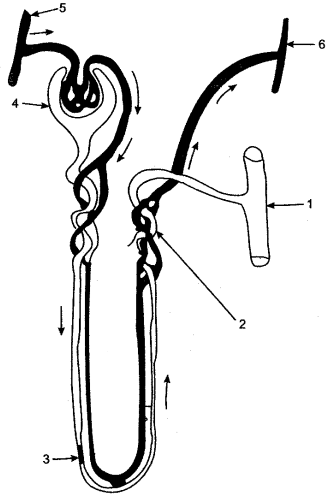
(i) Label parts 1,2,3 and 4.
(ii) State the reason for the high hydrostatic pressure in the glomerulus.
(iii) Name the blood vessel which contains the least amount of urea in this diagram.
(iv) Name the two main stages of urine formation.
(v) Name the part of the nephron which lies in the renal medulla.
Answer: (i) (1) Collecting tubule
(2) Distal convoluted tubule
(3) Loop of Henle.
(4) Bowman capsule.
(ii) The afferent arteriole entering the Bowman capsule is wider than the efferent arteriole which leaves it. So more blood is entering and less blood is moving out of the glomerulus.
(iii) Renal venuole.
(iv) Ultrafilteration and Reabsorption.
(v) Loop of Henle.
Question 2: The diagram shows the Excretory System of a Human being. Study the same and then answer the questions that follow:
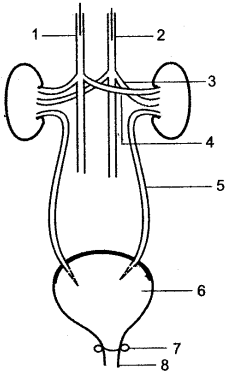
(i) Name the parts labeled 1, 2,3, and 4.
(ii) Give the main function of the parts labeled 5,6, 7 and 8.
(iii) Name the endocrine gland which could be added in diagram and state its location/position.
Answer: (i) (1) Renal artery,
(2) Aorta,
(3) Renal arteries,
(4) Renal vein
(ii) (5) Ureter—Carry urine to the bladder.
(6) Urinary bladder—Store urine
(7) Sphincter muscle—Control the voiding of urine
(8) Urethra—Urine released periodically.
(iii) Adrenal gland—At the top of kidney.
Question 3: Study the diagram given below and then answer the questions that follow:
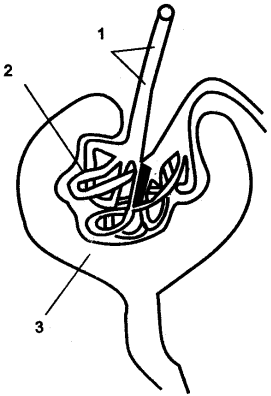
(i) Name the region in the kidney where the shown structure is present ?
(ii) Name the parts labeled 1, 2,3 and 4.
(iii) Name the stages involved in the formation of urine.
(iv) What is the technical term given to the process occurring in 2 and 3 ?
Briefly describe the process.
Answer: (i) Renal cortex
(ii) 1. Afferent arteriole
2. Glomerulus
3. Bowman capsule
(iii) Ultrafilteration, reabsorption and tubular secretion.
(iv) Ultrafilteration: In it blood entering the glomerulus under great pressure, is filtered. The liquid part of the blood filters through the walls of glomerular capillaries and Bowman’s capsule and enters into the nephron where it is called the glomerular filterate.
Question 4: Given below is the figure of certain organs and associated parts in the human body, study the same and then answer the questions that follow:

(i) Name all the organ systems shown completely or even partially.
(ii) Name the parts numbered 1 to 5.
(iii) Name the structural and functional unit of the part marked ‘1’.
(iv) Name the two main organic constituents of the fluid that flows .down the part labeled ‘3’.
(v) Name the two major steps involved in the formation of the fluid that passes down the part labeled ‘3’.
Answer: (i) Excretory system, circulatory system, Endocrine system.
(ii) 1. Left kidney, 2. dorsal aorta, 3. right ureter, 4. urinary bladder, 5. urethra.
(iii) Nephron or kidney tubules.
(iv) (a) Urea, (b) Uric acid.
(v) (a) Ultrafiltration, (b) Selective reabsorption.
Question 5: The diagram below represents a mammalian kidney tubule (nephron) and its blood supply. Parts indicated by the guidelines 1 to 8 are as follows:
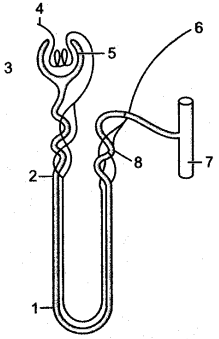
1. U-shaped loop of Henle
2. Proximal convoluted tubule with blood capillaries
3. Bowman’s capsule
4. Afferent arteriole from renal artery
5. Glomerulus
6. Venule to renal vein
7. Collecting tubule
8. Distal convoluted tubule with blood capillaries Study the diagram and answer the following questions in each case:
(i) Where does ultrafiltration take place ?
(ii) Which structure contains the lowest concentration of urea ?
(iii) Which structure contains the highest concentration of urea ?
(iv) Which structure contains the lowest concentration of glucose ?
(v) Where is the most water reabsorbed ?
Answer: (i) 3. Bowman’s capsule.
(ii) 6. Renal vein.
(iii) 8. Distal convoluted tubule with blood capillaries.
(iv) 7. Collecting tubule.
(v) 2. Proximal convoluted tubule with blood capillaries.
Question 6: Given below is a simple diagram of the human kidney cut open longitudinally. Answer the following questions:
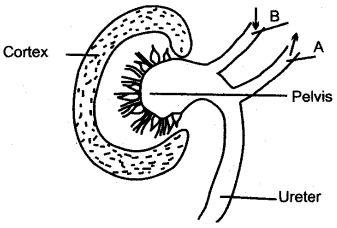
(i) Give the definition of excretion.
(ii) Name the units of the kidney.
(iii) Why does the cortex of the kidney show a ‘dotted’ appearance ?
(iv) Mention two functions of the kidney.
(v) Write two differences in the composition of the blood flowing through blood vessels A and B.
Answer: (i) Excretion is the process of removal of all harmful and unwanted products especially nitrogenous products from the body of living beings.
(ii) The units of the kidney are nephrons.
(iii) The dotted cortex of kidney shows the presence of nephrons (Bowman’s Capsule) in this region.
(iv) Two functions of kidney are:
(a) It expels out all the nitrogenous products produced in the body.
(b) It helps in osmoregulation.
(v) Two differences in the composition of blood flowing through blood vessels A and B are:
(a) A contains blood having large amount of water and nitrogenous wastes while blood in B is thicker and free from toxic substances.
(b) B carries more O2 and nitrogenous waste product as it is Renal Artery.
A carries CO2 and no nitrogenous products.
Sketch and Label the Diagram
Question 1: Draw a labeled diagram of the human kidney as seen in a longitudinal section.
Answer:
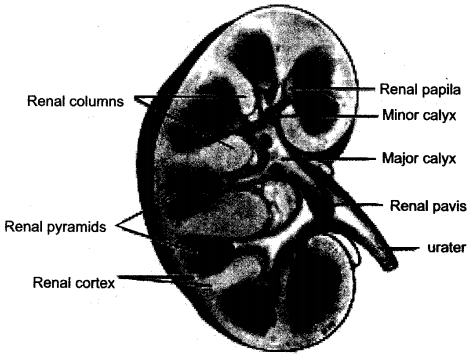
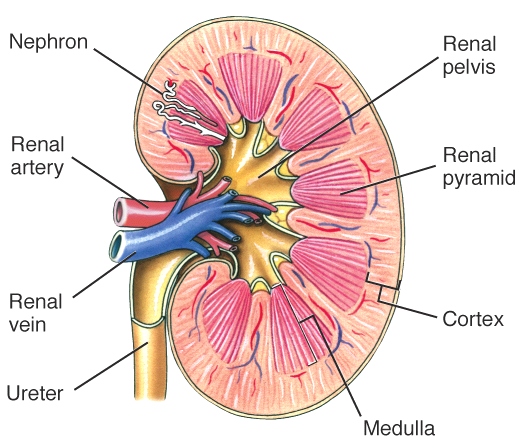
Question 2: Draw a well-labeled diagram of the human excretory system.
Answer: Diagram of human excretory system.
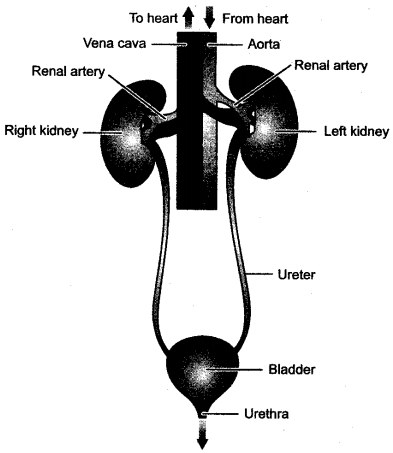
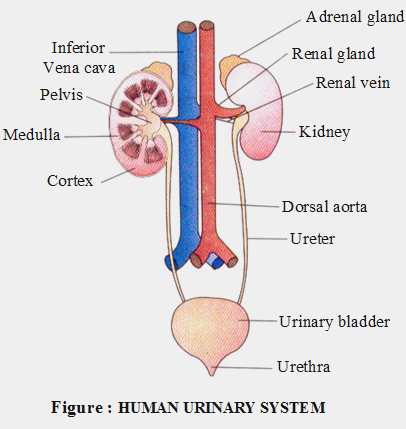
Question 3: Sketch and label the structure of malphigian body.
Answer:
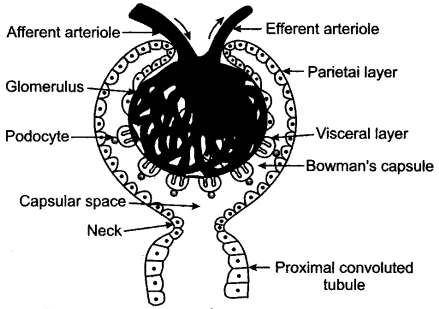
Question 4: Sketch and label the ultra structure of nephron.
Answer:
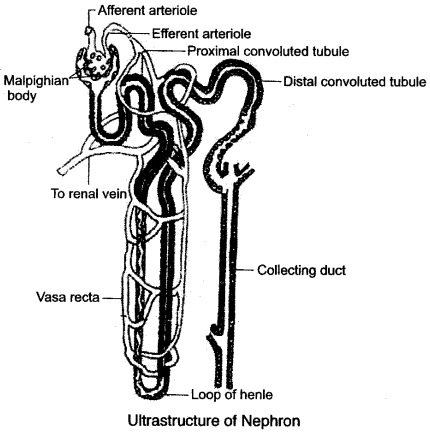
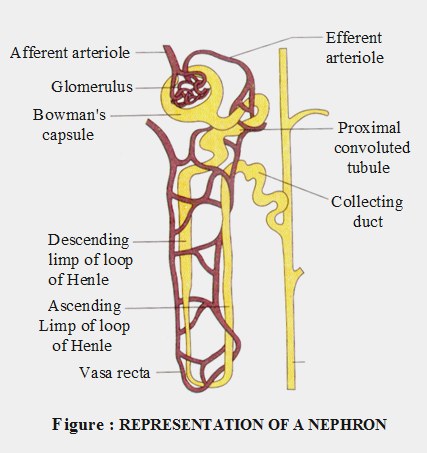
Explain the Terms
Question:
1. The Bowman’s capsule
2. Glomerulus
3. Loop of Henle
4. Ureter
5. Urinary bladder
6. Ureotelism
7. Malpighian body
8. Tubular reabsorption
Answer: 1. The Bowman’s capsule is also called the Nephric capsule and represents the free end of the nephron. The Bowman’s capsule is a double-walled cup-like structure which lies in the cortex of the kidney. The glomerular filtrate which leaves the blood capillaries of the glomerulus during ultrafiltration enter the capsule and then passes to the first part of the nephric tubule.
2. Glomerulus: A single afferent arteriole of the renal artery breaks up into a number of capillary branches to form the glomerulus. The blood in the glomerulus is subjected to higher pressure since the diameter of the afferent arteriole is wider than that of the efferent arteriole that leaves the glomerulus, so ultra-filtration takes place.
3. Loop of Henle: The cells that comprise the loop of Henle are well-adapted for diffusion, filtration and selective re-absorption. The final changes in the composition and the volume of the nephric filtrate occurs in the loop of Henle and the distal convoluted loop of the tubule. Glucose, amino acids, water, mineral salts and some other substances leave the loop of Henle to pass into the blood capillaries that surround it.
4. Ureter: From the hilum of a kidney, arises a narrow tube which carries the urine collected in the pelvis of the kidney to the urinary bladder which is situated at the base of the abdomen.
5. Urinary bladder: It lies at the base of the abdomen and has a thin, elastic and muscular wall. The urinary bladder receives the urine from the ureter. The wall of the bladder relaxes and the bladder expands to hold and store the urine, The urine cannot flow out continuously because of the contraction of the right sphincter muscles at its junction with the urethra. When the bladder is full, it contracts and the ring of sphincter muscles relaxes so that the urine is forced out through the urethra.
6. Certain animals predominantly excrete urea. Such animals are called ureotelic animals. Man also excretes urea, so he is called ureotelic and this phenomenon is termed as ureotelism.
7. It is a part of the nephron consisting of glomerulus and the Bowman’s capsule.
8. The nephrons have a tubular structure consisting of proximal and distal tubules which reabsorbs all the useful products present in the glomerular filtrate, and the process is called Tubular reabsorption.
Name the Following
Question:
1. Major excretory organs of man.
2. The organ which produces urea.
3. The structural and functional units of kidney.
4. The division of kidney which is light in colour and subdivided into conical renal pyramids.
5. The Inner concave margin of kidney.
6. The term used for Bowman’s capsule and glomerulus together.
7. The branch of renal artery which enters into Bowman’s capsule.
8. The blood vessels which brings pure blood to the kidneys:
9. A process by which the unwanted nitrogenous wastes are eliminated from the body.
10. Thin membranous sac serving as the reservoir of urine.
11. The muscle which controls urination.
12. The act of passing urine.
13. The organ in which urine is stored before its elimination.
15. The product which is excreted by the liver.
14. The process by which kidneys regulate the water content of the body.
16. The gas excreted by the lungs.
17. The substance found in excess in the urine of a diabetic patient.
Answer:
1. Kidneys
2. Liver
3. Nephrons
4. Medulla
5. Hilus
6. Renal corpuscle
7. Afferent arteriole
8. Renal arteries
9. Excretion
10. Urinary bladder
11. Sphincter muscle
12. Micturition
13. Urinary bladder
14. Osmoregulation
15. Bile pigments
16. Carbon dioxide
17. Glucose
Give Technical Terms
Question:
The organ which filters out urea and uric acid from the blood stream.
2. Name the organ in which urine is stored before its elimination from the body.
3. The organ in man concerned with maintaining water balance in the body.
4. The nitrogenous wastes produced in man.
5. The waste product which is excreted by the liver.
6. What are the organic constituents of normal human urine ?
7. Name two substances found both in urine and sweat.
8. The pigments produced by the breakdown of haemoglobin in liver ?
9. The tube joining the kidney to the urinary bladder.
10. The outer part of the kidney containing the Bowman’s capsule.
11. The duct which transports urine from the kidney to the urinary bladder.
12. A mass of fine blood capillaries found in each Bowman’s capsule.
13. Name three substances that are reabsorbed from the renal tubules by the secondary capillaries.
14. What are some common excretory product ?
15. The hormone that helps increase the reabsorption of water from the kidney tubules.
16. Which vessel will have the highest concentration of urea long after meal ?
17. Name the substance found in excess in the urine of a diabetic person.
Answer:
1. Kidney
2. Urinary bladder
3. Kidney
4. Urea, uric acid
5. Urea
6. Protein, acetone, creatinine
7. Uric acid and water
8. Urochrome, bilirubin and biliverdin
9. Ureter
10. Cortex
11. Ureter
12. Glomerulus
13. Glucose, amino acid, and some salts of sodium and potassium
14. Ammonia, salts, urea, uric acid etc.
15. Vasopressin or Antidiuretic Hormone [ADH]
16. Renal artery
17. Sugar
Fill in the Blanks
Complete the following sentences with appropriate words :
1. The process of removing the metabolic waste from the body is known as Excretion.
2. Human kidney is made up of Nephrons.
3. Nephron is the functional unit of kidney.
4. The sum total of all the chemical reactions taking place in the cell is known as Metabolism.
5. The process of releasing urine is Micturition.
6. The U-shaped portion of a nephron located in the medulla region is called Henle’s loop.
7. The knot of blood vessel inside the Bowman’s capsule is Glomerulus.
8. The duct which transports urine from kidney to urinary bladder is Ureter.
9. Renal artery supplies blood to kidney.
10. The human liver converts ammonia into Urea.
11. Besides excretion, the kidneys also carry out the important function of Osmoregulation.
12. Automatic self-regulation of salt and water within the body is known of Homeostasis.
13. The outer surface of the kidney is Convex while the inner surface is concave.
14. Urine is collected in the Urinary bladder.
15. Sweat formed in the sweat glands passes into the sweat duct which opens to the outside at the surface of the skin by means of Sweat pore.
True & False
Mention, if the following statements are True or False. If false rewrite the wrong statement in its correct form:
1. Sometimes urine may contain certain excess vitamins. (True)
2. Harmful ammonium compounds formed during the metabolism in the cells are broken down to form urea in the kidney. (False, Harmful ammonium compounds formed during the metabolism in the cells are broken down to form urea in the liver.)
3. Ammonia is converted into urea in kidney. (False, Ammonia is converted into urea in liver.)
4. Urine leaves the urinary bladder of a female by means of the uterus. (False, Urine leaves the urinary bladder of a female by means of the urethra.)
5. Urethra carries urine from the kidney to the urinary bladder. (False, Ureters carry urine from the kidney to the urinary bladder.)
6. Glomerular filtration occurs under pressure on the blood as a result of systolic pressure of the heart. (True)
7. Glomerular filtrate consists of many substances such as water, salts, glucose and white blood corpuscles. (True)
8. A diuretic increases the amount of urine. (True)
State the Location
| Name | Location |
| Urinary bladder | It lies in the pelvic of the abdomen. |
| Kidneys | Along the posterior abdominal wall on either side of the vertebral column. |
| Renal pyramids | Medulla of Kidney. |
| Medulla of Kidney | In the cortex of Kidney. |
State the Function
Write the functional activity of the following structures:
| Name | Function |
| Nephron | Reabsorption. |
| Bowman’s capsule | Ultra filtration. |
| Vasopressin | Water reabsorption |
| Aldosterone | Na+ reabsorption. |
| Glomerulus | Filtration of blood |
| Bladder sphincter | Regulates micturition. |
| Henle’s loop | Absorption of water from glomerular filtrate. |
| Sweat glands | Excretion by eliminating extra water and salts. |
| Kidney | Excretion of waste materials from the body. |
| Ureter | Transfer of urine from kidneys to bladder. |
| Bladder | Storage of urine. |
| Urethra | Passage for urine and sex cells. |
| Adrenal gland | Secretion of hormones. |
| Renal artery | Supply of blood to the kidneys, (oxygenated blood). |
| Renal vein | Collection of blood from the kidneys, (deoxygenated blood). |
| Iliac artery | Supply blood to hind limbs. |
| Iliac vein | Collection of blood from hind limbs. |
Choose the Odd One Out
1. Skin, Kidney, Liver, Lung. (Kidney)
2. Liver, Angiotensin, Kidney, ADH. (ADH)
3. Renal pelvis, Medullary pyramid, Renal cortex, Renal papilla. (Renal cortex)
4. Proximal convoluted tubule, Distal convoluted tubule, Henle’s loop, Renal corpuscle. (Renal corpuscle)
5. Afferent arteriole, Efferent arteriole, Vasa recta, Glomerulus. (Vasa recta Uterus)
6. Antidiuretic hormone, Excretion, Collecting tubule, Hypotonic urine. (Excretion)
7. Glucose, Amino acids, Urea, Na+. (Urea)
8. Urea, Carbonic acid, Creatinine, Uric acid. (Carbonic acid)
9. Urea, Uterus, Urinary bladder, Ureter. (Uterus)
Multiple Choice Questions
1. Excretion commonly involves :
(a) Removal of all by-products during catabolism
(b) Removal of by-products during anabolism
(c) Removal of nitrogenous waste
(d) All of the above
2. Urea is synthesized from extra amino acids in:
(a) Kidney (b) Liver
(c) Uriniferous tubules (d) Blood
3. What is the chief nitrogenous waste in mammals ?
(a) Amino acid (b) Ammonia
(c) Uric acid (d) Urea
4. Profuse sweating take place during heavy muscular exercise. The reason is :
(a) To excrete excessive amount of sodium chloride
(b) To eliminate excessive lactic acid produced due to anaerobic metabolism
(c) To regulate the temperature of the body
(d) All of these
5. Ultrafiltration occurs in :
(a) Bowman’s capsule (b) Proximal convoluted tubule
(c) Henle’s loop (d) Distal convoluted tubule
6. In the Bowman’s capsule :
(a) Afferent arteriole is narrower whereas efferent arteriole is wider
(b) Afferent arteriole is wider whereas efferent arteriole is narrower
(c) Afferent capillary is wider and efferent capillary is narrower
(d) Afferent capillary is narrow and efferent capillary is wide
Match the Column
Column ‘II’ is a list of items related to ideas in Column ‘I’. Match the term in Column ‘II’ with the suitable idea given in Column ‘I’.
| Column I | Column II |
| (i) Liver | (a) basic unit of the brain |
| (ii) Ova | (b) stimulated by light |
| (iii) Alveoli | (c) deoxygenated blood |
| (iv) Cochlea | (d) part of the sclera |
| (v) Vein | (e) haploid cell |
| (vi) Neuron | (f) blind sacs |
| (vii) Stomata | (g) found in the kidney |
| (viii) Grana | (h) audio receptors |
| (i) diffusion of gases | |
| (j) breakdown of proteins | |
| (k) diploid cell |
Answer: (i) (j) (ii) (e) (iii) (f) (iv) (h) (v) (c) (vi) (a) (vii) (i) (viii) (b)
For More Resources